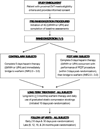Rationale and design of the ATTRACT Study: a multicenter randomized trial to evaluate pharmacomechanical catheter-directed thrombolysis for the prevention of postthrombotic syndrome in patients with proximal deep vein thrombosis
- PMID: 23537968
- PMCID: PMC3612268
- DOI: 10.1016/j.ahj.2013.01.024
Rationale and design of the ATTRACT Study: a multicenter randomized trial to evaluate pharmacomechanical catheter-directed thrombolysis for the prevention of postthrombotic syndrome in patients with proximal deep vein thrombosis
Abstract
Background: Current standard therapy for patients with acute proximal deep vein thrombosis (DVT) consists of anticoagulant therapy and graduated elastic compression stockings. Despite use of this strategy, the postthrombotic syndrome (PTS) develops frequently, causes substantial patient disability, and impairs quality of life. Pharmacomechanical catheter-directed thrombolysis (PCDT), which rapidly removes acute venous thrombus, may reduce the frequency of PTS. However, this hypothesis has not been tested in a large multicenter randomized trial.
Study design: The ATTRACT Study is an ongoing National Institutes of Health-sponsored, Phase III, multicenter, randomized, open-label, assessor-blinded, parallel two-arm, controlled clinical trial. Approximately 692 patients with acute proximal DVT involving the femoral, common femoral, and/or iliac vein are being randomized to receive PCDT + standard therapy versus standard therapy alone. The primary study hypothesis is that PCDT will reduce the proportion of patients who develop PTS within 2 years by one-third, assessed using the Villalta Scale. Secondary outcomes include safety, general and venous disease-specific quality of life, relief of early pain and swelling, and cost-effectiveness.
Conclusion: ATTRACT will determine if PCDT should be routinely used to prevent PTS in patients with symptomatic proximal DVT above the popliteal vein.
Trial registration: ClinicalTrials.gov NCT00790335.
Copyright © 2013 Mosby, Inc. All rights reserved.
References
-
- Kahn SR, Shrier I, Julian JA, et al. Determinants and time course of the postthrombotic syndrome after acute deep venous thrombosis. Ann Intern Med. 2008;149:698–707. - PubMed
-
- Kahn SR, Shbaklo H, Lamping DL, et al. Determinants of health-related quality of life during the 2 years following deep vein thrombosis. J Thromb Haemost. 2008;6:1105–1112. - PubMed
-
- Guanella R, Ducruet T, Johri M, et al. Economic burden and cost determinants of deep vein thrombosis during 2 years following diagnosis: a prospective evaluation. J Thromb Haemost. 2011;9(12):2397–2405. - PubMed
-
- Meissner MH, Manzo RA, Bergelin RO, et al. Deep venous insufficiency: the relationship between lysis and subsequent reflux. J Vasc Surg. 1993;18:596–608. - PubMed
Publication types
MeSH terms
Substances
Associated data
Grants and funding
LinkOut - more resources
Full Text Sources
Other Literature Sources
Medical


